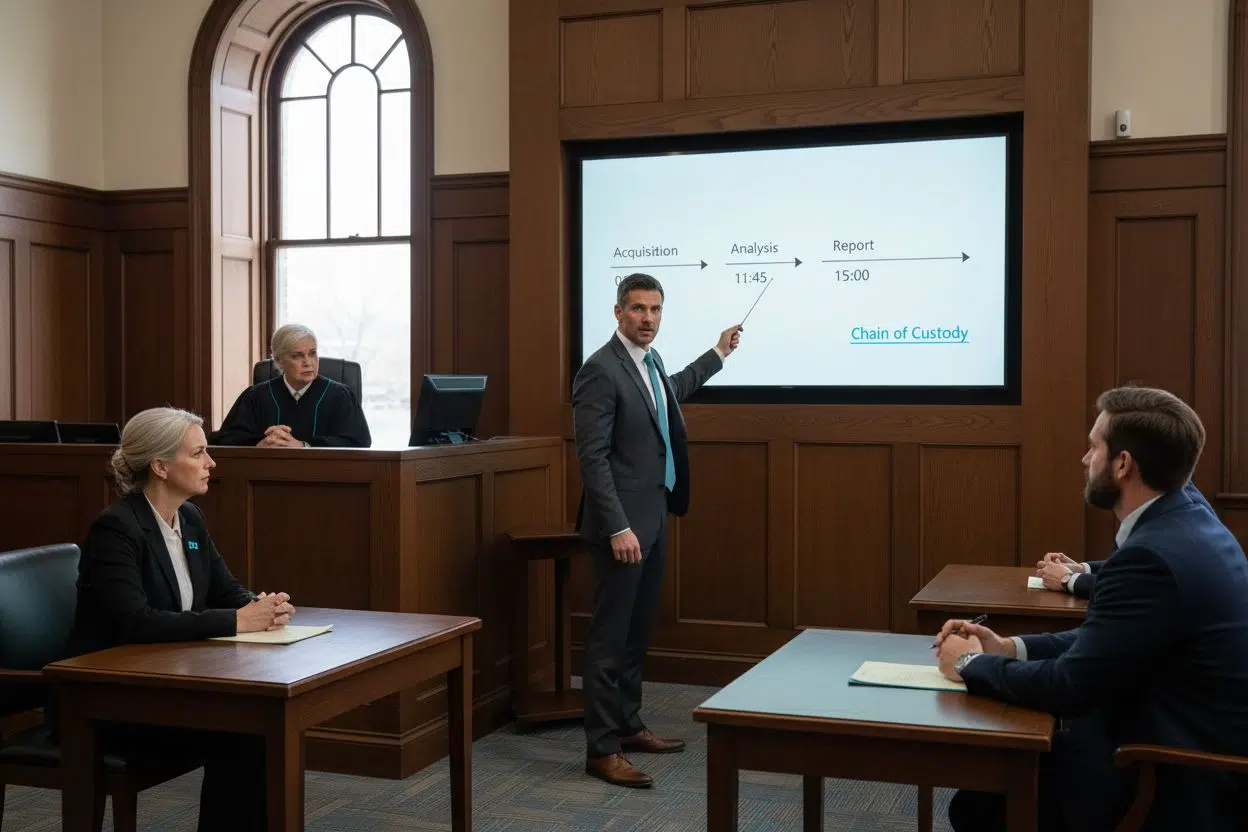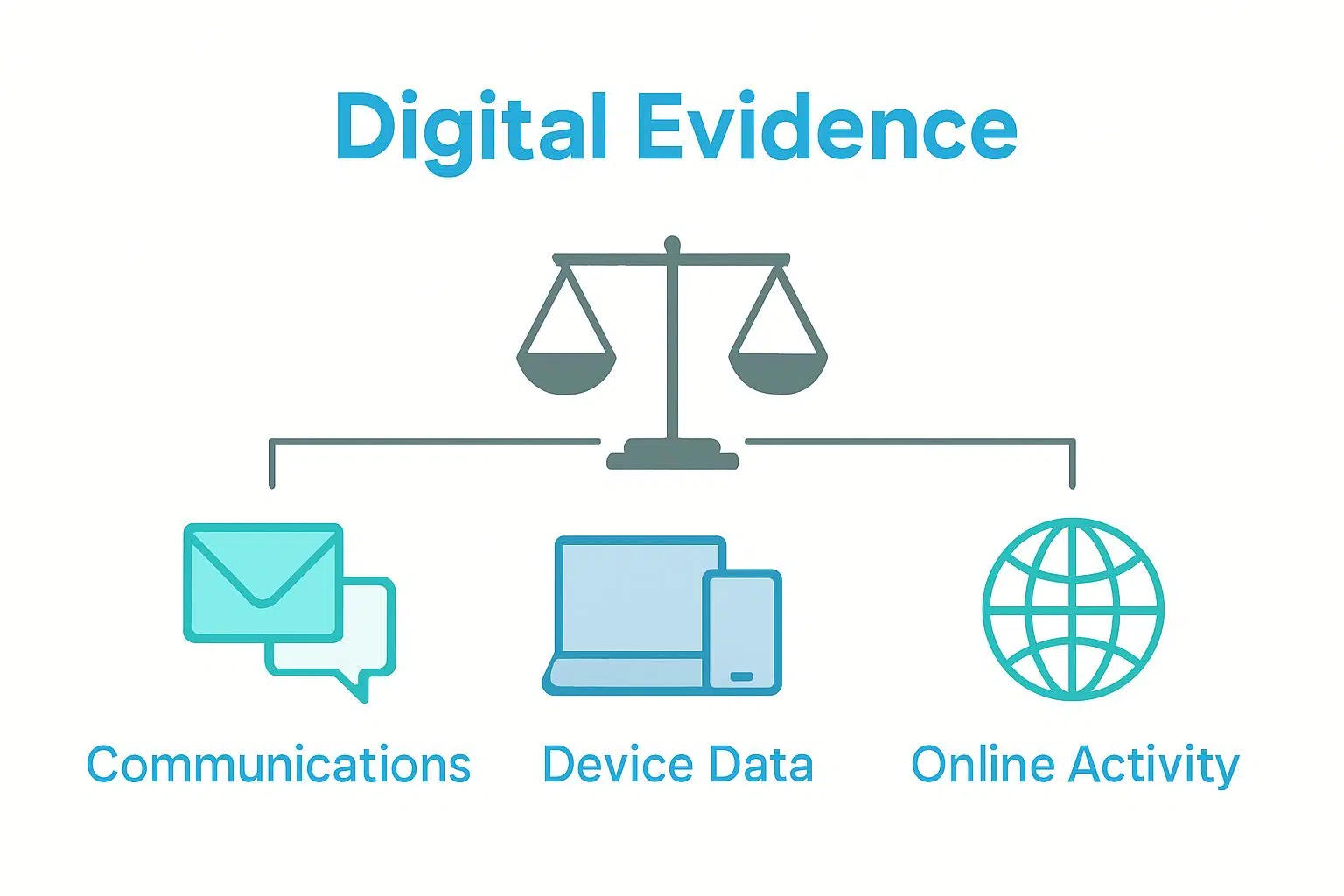Digital forensics now sits at the centre of major court cases. Ninety percent of modern legal disputes involve digital evidence from devices like smartphones and computers. That number might sound huge and it’s only growing. Most people expect dramatic police raids or physical evidence to tip a case but the real truth is hidden in those digital traces you leave every day. Digital forensics is transforming simple data into the most reliable proof the courts have ever seen.
Table of Contents
- The Role Of Digital Forensics In Legal Proceedings
- Understanding The Importance Of Digital Evidence
- How Digital Forensics Supports Legal Arguments
- Key Concepts And Techniques In Digital Forensics
- Real-World Applications Of Digital Forensics In Litigation
Quick Summary
| Takeaway | Explanation |
|---|---|
| Digital forensics is crucial in legal investigations | It enables the extraction and analysis of electronic evidence that can substantiate or challenge claims in court. |
| Maintain chain of custody for evidence integrity | Documenting evidence collection processes is vital to ensure that digital evidence is legally admissible and has not been tampered with. |
| Expert reports can enhance admissibility of evidence | Comprehensive reports generated by forensic experts detail methodologies and findings, making them useful in legal proceedings. |
| Variety of digital evidence types available | Digital evidence can come from communication records, logs, geolocation data, and financial records, providing crucial insights in cases. |
| Rigorous methodologies ensure reliability and validity | Forensic experts must follow strict scientific standards to guarantee that the evidence is collected and analysed correctly. |
The Role of Digital Forensics in Legal Proceedings
Digital forensics has become an indispensable tool in contemporary legal proceedings, transforming how evidence is collected, analysed, and presented in both criminal and civil litigation. This sophisticated investigative discipline enables legal professionals to extract, preserve, and examine digital information from various electronic devices and systems.
Uncovering Digital Evidence
In legal contexts, digital forensics serves as a critical mechanism for uncovering electronic evidence that can substantiate or refute claims. Professionals meticulously retrieve data from computers, smartphones, tablets, cloud storage, and network systems without compromising its integrity. The process involves creating precise forensic images of digital media, ensuring that original data remains unaltered while investigators conduct comprehensive analyses.
Key capabilities of digital forensics in legal proceedings include:
- Recovering deleted files and communications
- Reconstructing digital timelines of events
- Identifying potential tampering or unauthorized access
- Tracing digital communication patterns
- Verifying authenticity of electronic documents
Expert Testimony and Chain of Custody
Perhaps most critically, digital forensics provides expert scientific documentation that can withstand rigorous legal scrutiny. Forensic experts can generate comprehensive reports detailing their investigative methodology, which can be presented as admissible evidence in court. Our detailed guide on understanding digital forensics techniques offers deeper insights into these professional standards.
The concept of chain of custody becomes paramount in digital investigations. Every step of evidence collection and analysis must be meticulously documented to demonstrate that digital evidence has not been modified or compromised. This ensures the legal system can trust the electronic information presented during litigation.
According to research from the National Institute of Justice, maintaining strict forensic protocols is essential for ensuring digital evidence remains legally valid and scientifically credible. Digital forensics professionals follow internationally recognised standards that guarantee the reliability and admissibility of electronic information in legal proceedings.
Understanding the Importance of Digital Evidence
Digital evidence represents an increasingly critical component of modern legal proceedings, offering unprecedented insights into complex legal scenarios across criminal and civil litigation. As technological interactions become more prevalent, electronic data has transformed from supplementary information to primary investigative material.
Types of Digital Evidence
Digital evidence encompasses a broad spectrum of electronic information that can be systematically collected and analysed. These sources provide comprehensive digital footprints that capture crucial details about individual actions and communications.
Below is a table summarising the main types of digital evidence discussed in the article, along with brief descriptions to clarify their significance in legal investigations.
| Type of Digital Evidence | Description |
|---|---|
| Electronic communication records | Messages, emails, and other digital correspondence |
| Computer system logs | Records of system events and user activities |
| Geolocation data | Data revealing locations and movements |
| Social media interactions | Posts, messages, and engagements on social media platforms |
| Financial transaction records | Digital records of financial exchanges and payments |
| Cloud storage contents | Data stored in cloud-based services |
| Mobile device metadata | Background data on usage, times, and device characteristics |
Key types of digital evidence include:
- Electronic communication records
- Computer system logs
- Geolocation data
- Social media interactions
- Financial transaction records
- Cloud storage contents
- Mobile device metadata
Legal Significance and Reliability
The legal system increasingly recognises digital evidence as a credible and authoritative source of information. Unlike traditional physical evidence, electronic data can provide granular details about events, interactions, and intentions. Learn more about digital forensic techniques for legal investigations to understand how professionals extract meaningful insights.
According to research from the US Department of Justice, digital evidence offers unique advantages: it can be precisely copied without degradation, maintains comprehensive timestamps, and can reveal intricate communication patterns that might otherwise remain hidden.
Forensic experts must apply rigorous scientific methodologies to ensure digital evidence meets strict legal admissibility standards. This involves demonstrating that electronic data has been collected, preserved, and analysed using validated techniques that prevent contamination or manipulation.
How Digital Forensics Supports Legal Arguments
Digital forensics plays a pivotal role in constructing robust legal arguments by providing scientifically validated electronic evidence that can substantiate or challenge claims across various legal proceedings. By transforming raw digital data into comprehensive, legally admissible insights, forensic experts bridge the gap between complex technological information and clear legal narratives.
Establishing Factual Context
In legal arguments, digital forensics serves as a critical tool for establishing precise factual contexts. Forensic investigators can reconstruct digital timelines, trace communication patterns, and uncover hidden electronic interactions that might otherwise remain obscured. This capability allows legal professionals to present objective, verifiable evidence that goes beyond traditional witness testimonies.
Key ways digital forensics supports legal arguments include:
- Authenticating electronic documents
- Verifying communication sequences
- Identifying potential digital manipulation
- Reconstructing digital activity histories
- Correlating electronic evidence across multiple sources
Expert Analytical Techniques
Forensic experts employ sophisticated analytical techniques that transform raw digital data into compelling legal narratives. Explore our comprehensive guide on computer forensics techniques to understand the intricate methodologies used in digital investigations.
According to research from the European Network of Forensic Science Institutes, digital forensics techniques can provide unprecedented levels of detail. Experts can recover deleted files, analyse metadata, and trace digital interactions with remarkable precision, offering legal teams powerful evidentiary tools that can decisively influence case outcomes.
By applying rigorous scientific protocols, digital forensics professionals ensure that electronic evidence meets stringent legal standards. This approach transforms complex technological data into clear, comprehensible arguments that can withstand intense judicial scrutiny, making digital forensics an indispensable asset in modern legal proceedings.
Key Concepts and Techniques in Digital Forensics
Digital forensics represents a sophisticated scientific discipline that combines technological expertise with meticulous investigative methodologies. By employing advanced techniques, forensic professionals can extract, analyse, and preserve electronic evidence with remarkable precision and reliability.
Fundamental Investigation Techniques
The core of digital forensics lies in its ability to recover and analyse electronic data while maintaining strict evidentiary integrity. Forensic experts utilise specialised techniques that go far beyond simple data retrieval, focusing on comprehensive digital reconstruction and detailed contextual analysis.
The following table outlines the key forensic investigation techniques mentioned in the article, demonstrating the breadth of approaches used to extract reliable electronic evidence.
| Technique | Purpose |
|---|---|
| Forensic disk imaging | Creates an exact copy of digital storage |
| Metadata extraction | Retrieves data about files (dates, origins) |
| Network traffic analysis | Examines data transmissions over networks |
| Memory forensics | Analyses volatile memory for hidden data |
| Deleted file recovery | Recovers files thought to be erased |
| Cryptographic analysis | Investigates encrypted or secured data |
| Steganography detection | Uncovers hidden information within files |
Critical forensic investigation techniques include:
- Forensic disk imaging
- Metadata extraction
- Network traffic analysis
- Memory forensics
- Deleted file recovery
- Cryptographic analysis
- Steganography detection
Scientific Methodologies
Professional digital forensics relies on rigorous scientific protocols that ensure reproducibility and legal admissibility. Explore our comprehensive guide on cybercrime investigation techniques to understand the intricate processes involved.
According to research from the US National Institute of Standards and Technology, digital forensic techniques must adhere to strict scientific standards. These methodologies involve creating exact digital replicas of storage media, maintaining comprehensive chain of custody documentation, and using validated software tools that prevent data contamination.
By combining technological sophistication with scientific rigour, digital forensics professionals transform complex electronic data into clear, legally defensible evidence that can withstand intense judicial scrutiny.
Real-World Applications of Digital Forensics in Litigation
Digital forensics has emerged as a transformative tool across multiple legal domains, providing critical insights that can decisively influence case outcomes in both criminal and civil proceedings. By meticulously extracting and analysing electronic evidence, forensic experts help legal professionals uncover hidden truths and establish factual narratives with unprecedented precision.
Diverse Legal Contexts
The application of digital forensics spans a wide range of legal scenarios, demonstrating its versatility and critical importance in modern litigation. From intellectual property disputes to complex criminal investigations, digital forensic techniques offer comprehensive investigative capabilities that traditional methods cannot match.
Key litigation areas where digital forensics plays a crucial role include:
- Corporate misconduct investigations
- Intellectual property theft cases
- Divorce and child custody proceedings
- Workplace harassment claims
- Cybercrime prosecutions
- Insurance fraud investigations
- Employment dispute resolution
Evidence Reconstruction and Validation
Explore our comprehensive insights into digital forensics data collection to understand the intricate processes involved in evidence gathering.
According to research from the International Association of Privacy Professionals, digital forensics enables legal teams to reconstruct complex digital interactions with remarkable accuracy. Experts can recover deleted communications, analyse metadata, and trace digital footprints that provide crucial context in legal disputes.
By transforming raw electronic data into comprehensible evidence, digital forensics professionals bridge the gap between technological complexity and legal requirements, offering invaluable support to litigation strategies across diverse legal domains.
Bring Clarity and Credibility to Your Legal Case with Expert Digital Forensics
When faced with the challenges discussed in this article, such as establishing a reliable chain of custody and extracting defensible digital evidence, relying on unverified methods or inexperienced providers can put your entire legal argument at risk. Modern litigation often demands the precise recovery of deleted files, structured analysis of metadata, and accurate reconstruction of digital timelines. These pain points can lead to lost cases or challenged evidence if not handled by real specialists.
Trust your digital evidence to the professionals. Explore how our Digital Forensics Examiner services are purpose-built for lawyers, law enforcement, businesses, and private individuals who need credible and admissible forensic reports. Or if your matter extends to electronic documents, see our expertise in Digital Document Forensics for support analysing cloud data, emails, and more. Take the next step and visit Computer Forensics Lab today to ensure your digital evidence stands up in court. Your case deserves the highest standard of digital investigation—contact us now for a confidential consultation.
Frequently Asked Questions
What is the role of digital forensics in legal proceedings?
Digital forensics plays a crucial role in legal proceedings by helping to uncover electronic evidence that can substantiate or refute claims. It involves the meticulous retrieval, preservation, and examination of digital information from various electronic devices, ensuring its integrity for use in court.
How can digital evidence be used to support legal arguments?
Digital evidence supports legal arguments by providing objective, verifiable insights into events and interactions. It enables legal professionals to establish factual contexts, authenticate documents, verify communications, and reconstruct digital timelines, enhancing the credibility of their cases.
What types of digital evidence can be collected in legal cases?
Types of digital evidence include electronic communication records, computer system logs, geolocation data, social media interactions, financial transaction records, cloud storage contents, and mobile device metadata, among others. Each type offers unique insights into the circumstances surrounding a legal case.
Why is maintaining a chain of custody important in digital forensics?
Maintaining a chain of custody is vital in digital forensics to demonstrate that digital evidence has not been altered or compromised. It involves documenting every step of evidence collection and analysis, ensuring that the electronic information is reliable and legally admissible in court.


